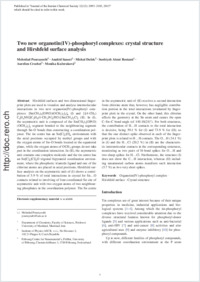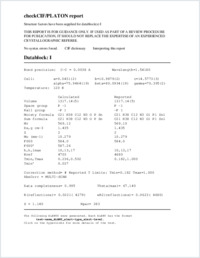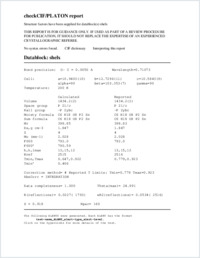Two new organotin(IV)-phosphoryl complexes: crystal structure and Hirshfeld surface analysis
- Pourayoubi, Mehrdad Department of Chemistry, Faculty of Sciences, Ferdowsi University of Mashhad, Mashhad, Iran
- Saneei, Anahid Department of Chemistry, Faculty of Sciences, Ferdowsi University of Mashhad, Mashhad, Iran
- Dušek, Michal Institute of Physics ASCR, Prague, Czech Republic
- Rostami, Soobiyeh Alemi Department of Chemistry, Faculty of Sciences, Ferdowsi University of Mashhad, Mashhad, Iran
- Crochet, Aurélien Fribourg Centre for Nanomaterial’s, FriMat, University of Fribourg, Switzerland
- Kučeraková, Monika Institute of Physics ASCR, Prague, Czech Republic
-
10.07.2015
Published in:
- Journal of the Iranian Chemical Society. - 2015, vol. 12, no. 12, p. 2093–2103
English
Hirshfeld surfaces and two-dimensional fingerprint plots are used to visualize and analyse intermolecular interactions in two new organotin(IV)-phosphoryl complexes: [Sn(CH₃)₂[OP(O)(OCH₃)₂]₂]n (I) and {[(4-CH₃)C₆H₄NH][C₅H₉(4-CH₃)N]₂P(O)}Sn(CH₃)₂Cl₂ (II). In (I), the asymmetric unit is composed of the Sn(CH₃)₂[OP(O)(OCH₃)₂]₂ segment bonded to the neighbouring segment through Sn–O bonds thus constructing a coordination polymer. The tin centre has an Sn[C]₂[O]₄ environment with the axial positions occupied by methyl groups and with the oxygen atoms of Sn–O bonds located at the equatorial plane, while the oxygen atoms of OCH₃ groups do not take part in the coordination interaction. In (II), the asymmetric unit contains one complete molecule and the tin centre has an Sn[C]₂[Cl]₂O trigonal bipyramid coordination environment, where the phosphoric triamide ligand and one of the chlorine atoms are placed in axial positions. Hirshfeld surface analysis on the asymmetric unit of (I) shows a contribution of 5.9 % of total interactions in crystal for Sn…O contacts related to involving of four-coordinated Sn site of asymmetric unit with two oxygen atoms of two neighbouring phosphates in the coordination polymer. The Sn centre in the asymmetric unit of (II) receives a second interaction from chlorine atom that, however, has negligible contribution portion in the total interactions (evaluated by fingerprint plot) in the crystal. On the other hand, this chlorine affects the geometry at the Sn atom and causes the open C–Sn–C bond angle (of 140.18(24)°). For both structures, the contribution of H…H contacts to the total interaction is decisive, being 59.1 % for (I) and 73.9 % for (II); so that the one distinct spike observed in each of the fingerprint plots is related to H…H contacts. The O…H (34.1 %) in (I) and the H…Cl (20.2 %) in (II) are the characteristic intermolecular contacts in the corresponding structures, monitoring as two pairs of H-bond spikes for O…H and two sharp spikes for H…Cl. Furthermore, the structure (I) does not show the C…H interaction, whereas (II) including unsaturated carbon atoms manifests such interaction (5.7 %) as two very short spikes.
- Faculty
- Faculté des sciences et de médecine
- Department
- Département de Chimie
- Language
-
- English
- Classification
- Chemistry
- License
-
License undefined
- Identifiers
-
- RERO DOC 257927
- DOI 10.1007/s13738-015-0686-9
- Persistent URL
- https://folia.unifr.ch/unifr/documents/304740
Other files
Statistics
Document views: 133
File downloads:
- pdf: 286
- Supplementary material: 138
- Supplementary material: 141


